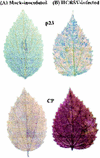The p23 protein of hibiscus chlorotic ringspot virus is indispensable for host-specific replication
- PMID: 12414971
- PMCID: PMC136886
- DOI: 10.1128/jvi.76.23.12312-12319.2002
The p23 protein of hibiscus chlorotic ringspot virus is indispensable for host-specific replication
Abstract
Hibiscus chlorotic ringspot virus (HCRSV) possesses a novel open reading frame (ORF) which encodes a putative 23-kDa protein (p23). We report here the in vivo detection of p23 and demonstrate its essential role in viral replication. The expression of p23 could be detected in protein extracts from transfected kenaf (Hibiscus cannabinus L.) protoplasts and in HCRSV-infected leaves. Further, direct immunoblotting of infected kenaf leaves also showed the presence of p23, and transient expression in onion and kenaf cells demonstrated that the protein is distributed throughout the cell. Site-directed mutagenesis showed that mutations introduced into the ORF of p23 abolished viral replication in kenaf protoplasts and plants but not in Chenopodium quinoa L. The loss of function of the p23 mutant M23/S33-1 could be complemented in trans upon the induced expression of p23 from an infiltrated construct bearing the ORF (pCam23). Altogether, these results demonstrate that p23 is a bona fide HCRSV protein that is expressed in vivo and suggest that p23 is indispensable for the host-specific replication of HCRSV. In addition, we show that p23 does not bind nucleic acids in vitro and does not act as a suppressor of posttranscriptional gene silencing in transgenic tobacco carrying a green fluorescent protein.
Figures







References
-
- Berthome, R., C. Kusiak, J. P. Renou, J. Albouy, M. A. Freire, and S. Dinant. 1998. Relationship of the pelargonium flower break carmovirus (PFBV) coat protein gene with that of other carmoviruses. Arch. Virol. 143:1823-1829. - PubMed
-
- Brunt, A. A., and N. J. Spence. 2000. The natural occurrence of Hibiscus chlorotic ringspot virus (Carmovirus; Tombusviridae) in aibika or bele (Abelmoschus manihot) in some South Pacific Island countries. Online New Dis. Rep. [Online.] 1:"http://www.bspp.org.uk/ndr/2000/2000.
Publication types
MeSH terms
Substances
LinkOut - more resources
Full Text Sources

